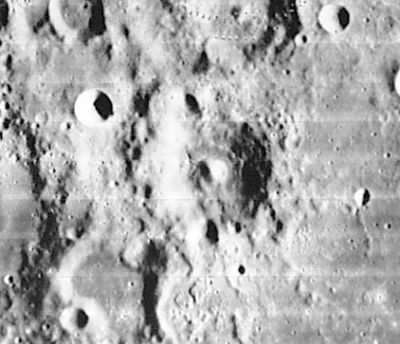Airy
Contents
Airy
|
Lat: 18.16°S, Long: 5.58°E, Diam: 38.9 km, Depth: 2.41 km, Rükl: 56 |

LOIV 101 H2 Airy is the crater with the strong central peak in the middle of the photo. Argelander is directly above it, truncated by the image margin.
Images
LPOD Photo Gallery Lunar Orbiter Images Apollo Images
- Airy was also captured on several frames made by Apollo 16's south-looking mapping/metric Fairchild camera, such as frame AS16-M-0707, in which Airy is noticeable near the central part of the curved horizon.
- Research: Danny Caes.
Maps
(LAC zone 95B2) LAC map Geologic map
Description
Elger
(IAU Directions) AIRY.--About 22 miles in diameter, connected with Argelander by a depression bounded by linear walls. Its border, double on the S.W., is broken on the S. by a prominent crater, with a smaller companion on the E. of it; and again on the N.W. by another not so conspicuous. It has a central peak. The next link in the chain of ring-plains is Airy c, a very irregular object, somewhat larger, and with, for the most part, linear walls.
Wikipedia
Additional Information
- IAU page: Airy
- Depth data from Kurt Fisher database
- Westfall, 2000: 2.41 km
- The central peak rises 1.1 km as measured on the east and 1.3 km when measured on the west Sekiguchi, 1972. - fatastronomer
- Satellite crater Airy A is on the ALPO list of banded craters
The Airy swirl
- An albedo feature to the west of Airy, between Airy and Parrot C, has recently been described as a swirl. The elongate curved bright area with a central darker lane is associated with a strong magnetic anomaly. The swirl covers about 1300 km^2.
- The swirl formation is noticeable at the lower half of Lunar Orbiter 4's photograph LOIV-101-h2.
- This "new" swirl was already discovered during the first half of the nineteen eighties by Danny Caes on the detailed yellowish-orange Full Moon photograph which was printed on the first pages of the December 1984 issue of Astronomy magazine.
- The southern part of the swirl was captured near the upper left corner of Apollo 14's orbital Hasselblad photograph AS14-73-10079.
- Apollo 16's oblique south-looking Fairchild photographs of the region south of Albategnius show the area with the swirl on it.
- AS16-M-2473 (Rev 48) shows the swirl between Albategnius (right) and the central part of the curved horizon.
- AS16-M-0708 (Rev 26) shows the same region south of Albategnius (low sun above the eastern horizon). Although there are many shadows in this image, the swirl is noticeable if one looks very carefully.
- Research: Danny Caes
Nomenclature
- Named for Sir George Biddell Airy FRS (July 27, 1801 – January 2, 1892), the British Astronomer Royal from 1835 to 1881. Airy's discovery of a new inequality in the motions of Venus and the Earth is in some respects his most remarkable achievement. He undertook the laborious task of reducing the enormous mass of observations of the moon made at Greenwich. As a result, no less than 8,000 lunar observations were rescued from oblivion, and were, in 1846, placed at the disposal of astronomers in such a form that they could be used directly for comparison with the theory and for the improvement of the tables of the moon's motion. One of the most remarkable of Airy's researches was his determination of the mean density of the earth. In 1826 the idea occurred to him of attacking this problem by means of pendulum experiments at the top and bottom of a deep mine.
- Sir George Biddell Airy's son was the doctor Hubert Airy (1838–1903); a pioneer in the study of migraine.
- Airy B, a crater east of Airy, was given the same Klepesta by Felix Chemla Lamèch, but the IAU did not adopt his suggestion (research: Ewen A. Whitaker and Danny Caes; August 2003, mail correspondence).
- The flat area between Parrot C and Airy, over part of which the Airy swirl occurs, is labeled the Loro basin on the greenish Rand McNally moonmap and on the same map in Patrick Moore's Atlas of the Universe (1983). The exact origin of the name Loro basin is unknown. The swirl also extends over Parrot G (research: Danny Caes). Was the Airy swirl already known by the people who introduced the informal name Loro basin?
LPOD Articles
Bibliography
- Hughes, C. G.; Blewett, D. T.; Hawke, B. R.; Richmond, N. C. 2006. Optical Maturity and Magnetic Studies of Lunar Swirls. 37th Annual Lunar and Planetary Science Conference, March 13-17, 2006, League City, Texas.
Airy in the Sourcebook Project (William R. Corliss)
- In Mysterious Universe, a handbook of astronomical anomalies (1979) :
- Page 576: A Peculiar Telescopic Phenomenon (Peter Doig, Journal of the British Astronomical Association, 1930).
Named Features -- Prev: Agrippa -- Next: Aitken